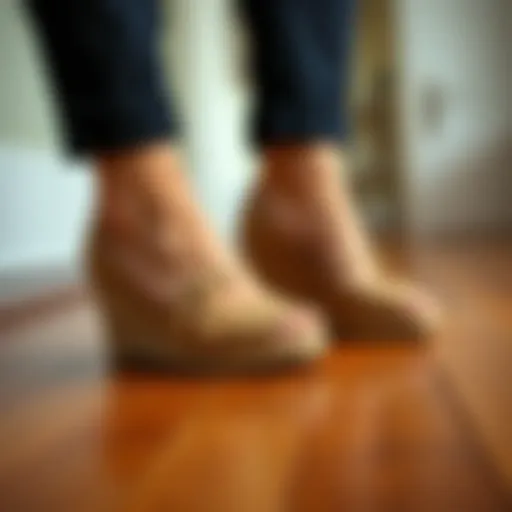Exploring the 70's Hippie Look: Fashion's Radical Roots
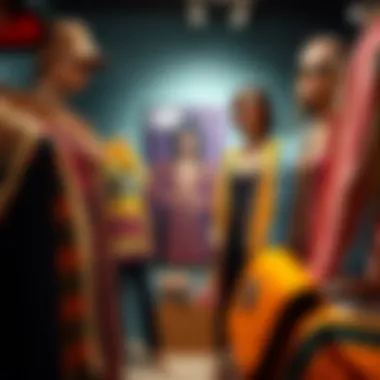
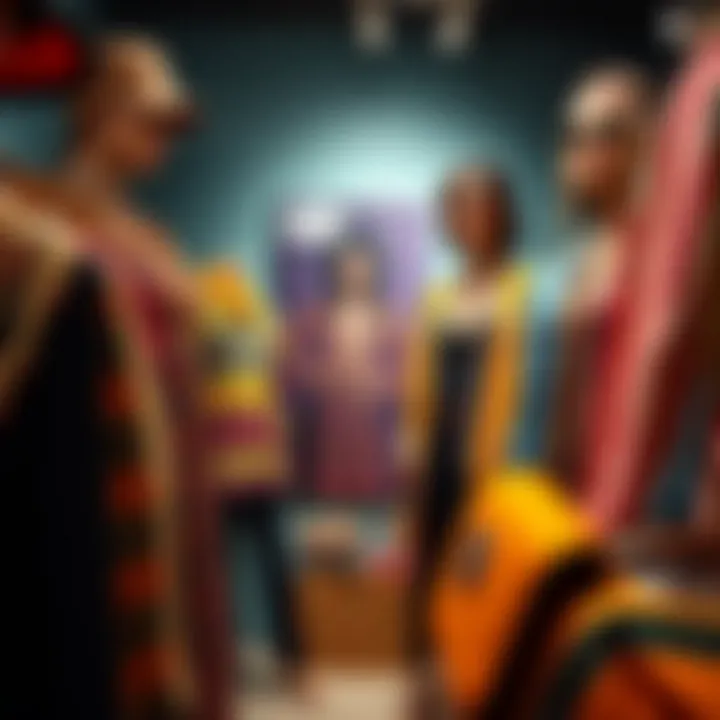
Intro
The 1970s was a decade that redefined the boundaries of fashion, and at the heart of this transformation was the hippie movement. As societies around the world grappling with change, new ideas about freedom and self-expression permeated every layer of culture, particularly in music, art, and, of course, fashion. The hippie look emerged not merely as a style but as an assertion of individuality and an opposition to the materialism and conservatism of previous generations. Amidst a backdrop of political tensions and social unrest, this distinct aesthetic weaved together elements of comfort, cultural symbolism, and a touch of rebellion, manifesting in a variety of outfits that helped define a generation.
In this exploration, we’ll dissect the core aspects of the 70s hippie fashion movement, including its roots in counterculture, the significant elements that characterized this iconic look, and its lasting impact on today’s fashion landscape. By offering practical tips for incorporating these vintage vibes into contemporary wardrobes, we aim to bridge the gap between past and present, making this radical fashion movement accessible to modern style enthusiasts.
From flowing fabrics to vibrant patterns, the key features of hippie attire reflect not only a lifestyle choice but also a broader societal aspiration towards peace, love, and communal living. This article serves as a thorough guide, ensuring that every reader, whether a seasoned fashion designer or a budding stylist, leaves with a richer understanding of this fascinating era.
Preface to the 's Hippie Look
The 70's hippie look isn't just a fleeting fashion trend; it's a rich tapestry woven from threads of rebellion, self-expression, and cultural liberation. This iconic aesthetic emerged from the heart of a counterculture that challenged prevailing societal norms, encouraging individuals to showcase their personalities through their choice of clothing. It's essential to understand that the hippie style is not only characterized by its vivid colors and bohemian patterns, but it also mirrors a profound shift in societal values.
From bell-bottom trousers to flowing maxi dresses, the hippie style captivates with a sense of freedom. Clothing was often crafted from natural materials, emphasizing comfort over conformity. This clothing trend was a declaration against the mass production of fashion, signaling a desire for authenticity and connection to the earth.
What sets apart the hippie look from other styles is its underlying philosophy. It's a call to embrace the unique, to transform clothing into a canvas of artistic expression. Through layering, mix-and-match strategies, and bold patterns, the hippie look fosters individuality and invites wearers to cultivate their identities boldly. Here are a few thoughts on what this means for various audiences:
- Fashion Designers: The 70's hippie look serves as a rich source of inspiration, pushing boundaries and encouraging the integration of modern sustainability into design practices.
- Stylists: Understanding the roots of hippie fashion allows stylists to reimagine its elements in contemporary settings, providing forward-thinking clients with outfits that tell stories.
- Retailers and Influencers: By embracing the vibrancy and depth of the hippie look, retailers can tap into an audience keen on authenticity, weaving this narrative into their marketing strategies.
The relevance of the 70's hippie look goes beyond mere nostalgia. As society grapples with concepts of identity and expression, the ability to incorporate this vibrant past into modern wardrobes becomes increasingly important. In a world increasingly cluttered with fast fleeting trends, the hippie aesthetic stands as a powerful reminder of the beauty found in freedom and individuality.
"Fashion is a way to say who you are without having to speak." - Rachel Zoe
The necessity of studying this unique period in fashion history cannot be understated; it offers valuable lessons about creating a sustainable, expressive future. By diving into the specifics of the hippie look, we can unravel how its influence continues to be felt in today's fashion landscape.
Historical Context of the Hippie Movement
The exploration of the hippie movement in the 1960s serves as a crucial background to understanding the iconic 70’s hippie look. This was a decade of transformation, where fashion evolved as a powerful form of self-expression reflecting deeper social and political currents. Examining the historical context provides insight into how a blend of art, music, and radical thinking birthed a whole new style, one that prioritized individuality and naturalism over mainstream fashion norms.
The Rise of Counterculture in the 1960s
During the 1960s, the United States was in a state of upheaval. Young people began to reject the conformist values of their parents. The counterculture emerged as a response to a myriad of factors, including the Vietnam War, civil rights movements, and widespread disillusionment with political institutions. This environment set the stage for a new way of thinking and living—essentially, a radical departure from traditional lifestyles.
The term “hippie” itself became synonymous with a lifestyle that embraced peace, love, and freedom. Counterculture advocated for a break from consumerism, which influenced the look that defined the hippie aesthetic. Bold choices—such as vibrant colors, unstructured garments, and artisanal craftsmanship—allowed individuals to showcase their values boldly.
It's essential to recognize that this wasn’t just a fashion statement; it was a collective statement of identity. Hippies congregated in communes, organized protests, and formed bands, all the while urging society to reconsider what it valued. A noticeable shift occurred as people began to convey individuality through their clothing. The natural fibers and flowing silhouettes became symbols of a deeper philosophy rooted in harmony with nature and rejection of corporate influence.
Key Features of the 's Hippie Look
The 70's hippie look serves as a beacon of freedom and self-expression, radiating from an era defined by its radical approach to fashion. Understanding the key features of this style is essential for grasping the broader cultural currents that shaped it. The aesthetic offered a means for individuals to reject societal norms while embracing personal identity and creativity. As we explore the elements that define the 70's hippie fashion, one sees not just a trend but a powerful statement about individuality and sustainable living. The looks from this era continue to inspire not only fashion designers but also social commentators looking to make sense of contemporary trends.
Flowy Silhouettes and Natural Fabrics
Flowy silhouettes and natural fabrics form the backbone of the 70’s hippie look. The use of light, breezy materials like cotton, linen, and hemp promotes a comfortable aesthetic, allowing full range of motion, ideal for the free-spirited lifestyles of the time. Flowing skirts and loose tops replaced the restrictive styles of the previous decades. This shift fundamentally represented a rebellion against the tight-fitting garments that constrained both body and spirit.
Often, these garments were adorned with intricate embroidery or lace, giving each piece a unique charm loaded with personality. The preference for natural fabrics aligned with the hippie ethos of harmony with nature. This style was not merely about comfort; it was a conscious choice reflecting a lifestyle that prioritized the environment. The flowing garments became a canvas for artistic expression, often displaying vibrant colors and textures that evoke the feeling of being one with nature.
Psychedelic Patterns and Earthy Tones
The heart of the hippie look pulsated with psychedelia and earthy tones. Bright colors and swirling motifs, reminiscent of the delving into the subconscious mind, became staples within this visual language. Tie-dye, fractal prints, and floral patterns splashed across garments, imbuing them with an almost visual energy that seemed to challenge traditional aesthetics.
Alongside these vivid patterns, earthy tones like olive greens, burnt oranges, and deep browns grounded the vibrancy, creating a balance that spoke to the era's eco-conscious sensibilities. The combination fostered a connection to the earth and a rejection of artificiality. Each pattern told a story — of peace, love, and resistance. This was not simply about appealing visuals; it was a shared language among the youth of the time, binding them into a collective experience driven by art and ideology.
Layering and Mix-Matching Styles
Layering and mix-matching styles were vital features of the hippie wardrobe. Within this framework, individuality soared. The ability to combine various garments into one looks encouraged personal expression. It wasn’t unusual to see a maxi dress under a crop top alongside bohemian vests, creating a unique identifier of personal flair.
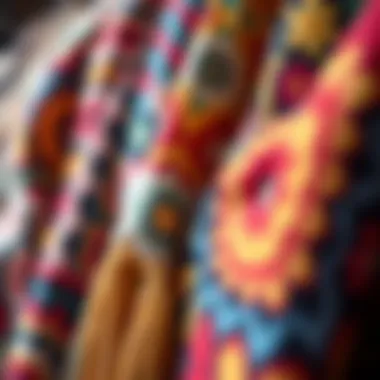
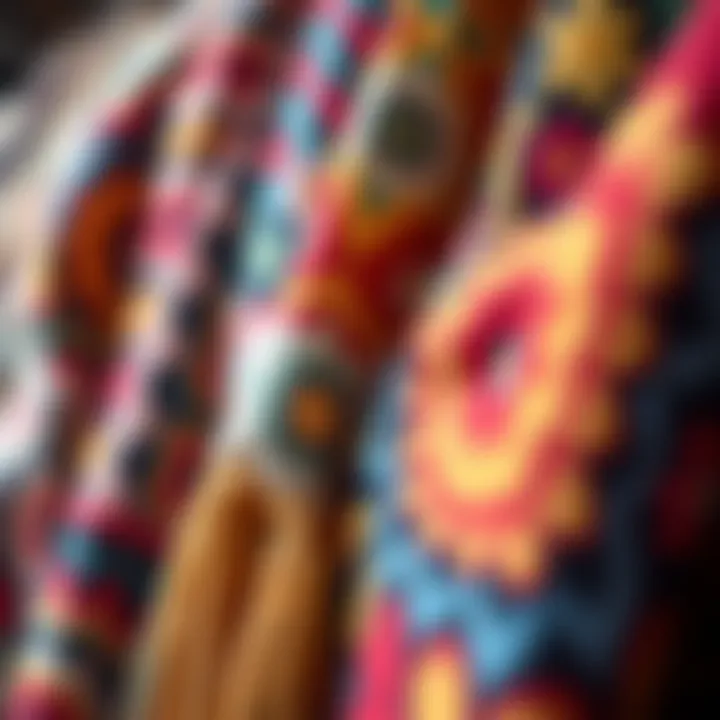
This layering wasn't haphazard; it was a refined practice of careful selection. Garments drawn from different cultures, timelines, and aesthetics merged into a singular expression of self. The beauty of this style was enriched by its versatility — a classic paisley print coat thrown over a simple tank top could convey both sophistication and comfort depending on the occasion. The ease and fluidity of the layered outfits revolved around the notion of versatility: one could adapt and express themselves at any moment.
The 70’s hippie look isn’t simply clothing; it's a narrative of peace, love, and personal freedom that continues to resonate.
These key features coalesce around the idea that fashion is not merely about garments but is a lived experience, an ongoing dialogue with culture, society, and self. Embracing this intuitive expression reveals the soul of the 70's hippie fashion — an enduring legacy that braids itself into the very fabric of contemporary style today.
Signature Clothing Items of the Era
The 70's hippie look is undeniably marked by its distinctive clothing items, each piece woven into the fabric of the counterculture movement. These garments did not just signify a style; they were laden with symbolism and philosophical undertones, resonating deeply with the ideals of freedom, individuality, and rebellion against the status quo. Understanding these signature clothing items provides key insights into how fashion served as a powerful voice amidst the tumult of the decade.
Bell-Bottoms and Flared Jeans
Bell-bottoms and flared jeans emerged as a vivid fashion statement that encapsulated the spirit of the 70s. Originally a feature of naval uniforms, the style transformed in the hands of hippies. The wide flares from the knees down provided a sense of flow and movement, echoing the free-spirited ethos of the era. These trousers became a canvas on which personal expression flourished through embellishments, patches, and dyes. Unlike straight-cut jeans, the bell bottoms were wildly versatile—paired with peasant tops for casual outings or tucked into tall boots for a more polished look. This ability to fuse comfort with style made bell-bottoms a staple in every hippie’s wardrobe.
"Fashion is a form of self-expression. Bell-bottoms screamed individuality in a crowded world."
Maxi Dresses and Skirts
Maxi dresses and skirts were another hallmark of the hippie aesthetic, resonating with themes of femininity and freedom. Flowing to the ankles, these garments are synonymous with the carefree vibe of the time. Made from soft, breathable fabrics, they often featured vibrant prints and patterns that reflected nature—floral, paisley, and tie-dye designs were especially prevalent. The maxi silhouette not only provided comfort but also embodied a rejection of traditional women’s fashion that constrained movement. By donning these long, flowing dresses, women weren't just making a fashion statement; they were symbolically casting off societal constraints, aligning with feminist movements of the decade.
Ethnic-Inspired Garments
Ethnic-inspired garments drew heavily from global cultures, with a noticeable influence from Indian, African, and Native American styles. These clothes often showcased intricate embroidery, vibrant colors, and unique textures, making them stand out in a typical wardrobe. The adoption of such styles was a reflection of the broader interest in worldwide cultures as well as a desire to connect with deeper meanings and narratives beyond Western norms. With items like caftans, kimonos, and tunics, wearers celebrated a harmonious connection with the world, embracing diversity and the counterculture's ethos of peace and understanding.
Vintage T-Shirts and Graphic Tees
In the quest for authenticity, vintage t-shirts and graphic tees became essential components of the hippie wardrobe. These shirts often bore slogans or images representing peace, love, and anti-establishment sentiments, acting almost as walking billboards for the movement. Whether promoting a band or conveying a message, graphic tees were a means of individual expression. Unlike the often-sterile corporate fashion of the day, these items offered wearers a connection to their favorite music, values, and beliefs, encapsulating the youthful rebellion of the era while remaining endlessly versatile.
These signature clothing items not only defined the 70's hippie look but also illustrated the movement's broader cultural impacts. Today, they serve as a reference point for modern fashion, proving that the essence of true style is not just about appearance, but the stories they tell.
Influential Accessories of Hippie Fashion
Accessories played an essential role in defining the hippie aesthetic. They were not mere add-ons; these items shifted the entire tone of an outfit and communicated the wearer’s beliefs and personality. The impact of accessories went beyond personal expression. They connected individuals to the broader cultural movements of the time, making fashion an integral part of their ideology. With an inclination towards nature, freedom, and individuality, here’s a closer look at some of the most influential accessories that shaped the 70's hippie look.
Headbands and Flower Crowns
Headbands and flower crowns were staples in the wardrobes of countless hippies. Headbands, often adorned with beads, feathers, and fringe, symbolized a carefree lifestyle and a break from conventional norms. They were versatile; often worn with flowing hair or even under a wide-brimmed hat. Flower crowns, on the other hand, brought a natural elegance to the ensemble. They celebrated the beauty of nature, aligning perfectly with the hippie affinity for all things organic.
- Symbolism: Flower crowns were particularly significant as they represented love, peace, and a connection to the earth.
- Variety: Whether made from artificial flowers or real blooms, they were customized to suit personal tastes, often matching the wearer's clothing.
"In a crowded festival scene, the bold colors and natural motifs of these accessories symbolized a shared sense of belonging and creativity."
The thing about headbands and crowns is they can evoke a feeling, a memory of freedom, which is why they're still fashionable today.
Chunky Jewelry and Beaded Necklaces
Chunky jewelry and beaded necklaces played a critical role in creating the eclectic 70's look. They were often handmade and could be seen dangling from houses along the streets or found at local fairs. These pieces not only added character to the hippie outfit but also reflected the wearer’s personality.
- Diversity of Materials: From wood to metal, colored glass to clay, the variety was endless. Every bead seemed to tell a story.
- Cultural Fusion: Many designs were inspired by various ethnic cultures, which resonated strongly with the hippie philosophy of unity and diversity.
Wearing this type of jewelry was about more than just aesthetics; it was a statement about individuality and a rejection of mass-produced fashion. In a world increasingly saturated with consumerism, chunky jewelry served as a reminder of handmade craftsmanship and the beauty of personal expression.
Footwear: Sandals and Platform Shoes
The footwear of the hippie movement encapsulated the era’s ethos of comfort and rebellion. Sandals became synonymous with the lifestyle, as they offered a practical and casual option for those who preferred a laid-back approach.


- Natural Materials: Many sandals were crafted from leather or woven fabrics, promoting a sense of returning to nature. The simplicity of sandals echoed the uncomplicated spirit of the times.
- Platform Shoes: On the other hand, platform shoes symbolized a bold statement. They added height and flair, often seen adorned with vibrant patterns or textures that matched the overall hippie fashion.
Finding the right pair of shoes was akin to making a social statement. Whether someone chose earthy sandals for comfort or flashy platforms for impact, it illustrated their alignment with or push against societal norms.
In understanding the accessories of this movement, we capture a nuanced picture of the 70's and how its elements resonated with deeper philosophies and social ideologies. The choices made in accessories reflected the struggle for identity and belonging in a rapidly changing society.
The Influence of Music and Festivals on Fashion
The intersection of music, festivals, and fashion has been a powerful driving force in shaping the 70's hippie look. This section takes a closer look at how vibrant sounds and communal gatherings influenced the clothing and styles that defined a generation. The music culture of the time was not just an auditory experience; it was a movement that sparked creativity and helped define identities through bold fashion choices.
Woodstock: A Defining Moment
Woodstock, held in 1969, was more than just a music festival; it became a cultural phenomenon that embodied the spirit of the era. The gathering, with its eclectic lineup featuring legends like Jimi Hendrix and Janis Joplin, created a platform where self-expression through clothing flourished. The atmosphere was electric, with a crowd made up of individuals who embraced the freedom associated with the hippie movement.
During Woodstock, the clothing worn by attendees reflected their values and attitudes. Tie-dye shirts, crochet vests, and floral prints were not just fashion statements; they represented a lifestyle choice that prioritized love, peace, and community over materialism. The sheer number of attendees wearing similar styles made the event an iconic showcase of hippie attire.
"Woodstock wasn’t just about the music; it symbolized an entire ethos that people wore proudly, loud and clear."
Moreover, the festival's backdrop of nature and an aura of rebellion allowed for experimentation with fabrics and accessories that had never been seen before. Participants used whatever they could find—often handmade or thrifted—to craft their outfits, pushing against mainstream fashion norms. It showed a desire for individuality while still fostering a sense of belonging, a central tenet of the hippie ideology.
Art and Music Festivals' Lasting Impact
The ripples of Woodstock were felt far beyond its three days. Art and music festivals in the following years, such as the Monterey Pop Festival and the Isle of Wight Festival, continued to shape fashion. These gatherings became fertile ground for new trends that drew significant inspiration from earlier events like Woodstock.
At these festivals, attendees adopted a broader color palette and experimented with styles that fused traditional hippie looks with modern elements. The 70's style became synonymous with vibrancy and freedom. Not just a phase, these events invited individuals to dress in ways that complemented their artistic expressions. Here, fashion transformed into a canvas where personal identity and collective spirit could merge.
The ongoing relationship between music festivals and fashion led to what we now know as festival fashion. Light dresses, bohemian accessories, and statement pieces became staples for those who celebrated the arts. The spirit of creativity remained, strongly influencing how fashion is perceived today. Even in contemporary culture, festivals continue to inspire modern designers and fashion-conscious individuals to dabble in the hippie style ethos.
In essence, music and art festivals served as dynamic platforms where culture and creativity intertwined, making lasting impressions on the fashion landscape of the 70's. They paved the way for generations to express themselves freely and boldly, ensuring that the hippie style's influence resonates in today's fashion world.
Symbolism and Statements in Hippie Attire
The 70's hippie look was far more than a mere trend; it represented a profound counterstatement to the status quo. In a world fraught with chaos, war, and social division, the fashion choices of the time served as a canvas for expressions of peace, love, and individuality. This section dissects how symbolism in hippie attire not only reflected personal beliefs but also contributed to broader social movements.
Fashion as a Form of Protest
Hippie attire was the embodiment of protest against mainstream society and its values. The psychedelic prints, which often resembled the vibrant colors of nature, were a reply to the sterile and gray aesthetics of corporate culture. These patterns were a bold declaration of freedom and self-expression. Wearing loose, flowing garments served both practical and ideological purposes—comfort in an ever-changing world and a rejection of restrictive norms.
- Peace Symbols: The incorporation of peace signs and other motifs into clothing galvanised a growing movement demanding an end to the Vietnam War. This symbolism wasn't merely decorative; it represented a yearning for societal change.
- Natural and Ethnic Influences: By donning garments inspired by various cultures, hippies made a statement about unity and appreciation for diversity. Items like tie-dye tops or kaftans communicated a rejection of Western consumerism and a call for a more harmonious existence with the planet.
- Thrift and Vintage: Choosing second-hand clothing was a significant statement as it opposed the fast-fashion industry. Wearing what someone else deemed obsolete was, in itself, an act of rebellion against materialism.
Moreover, the act of dressing counter to one’s surroundings fostered a sense of solidarity among those who felt marginalized by conventional standards. As the poet Allen Ginsberg once put it, "You can’t take the anger out of the verb of liberty that fashions what we wear."
The Role of Sustainable Practices
As environmental awareness began to creep into the collective consciousness during the 70s, the principles of sustainability found their place within the hippie aesthetic. At a time when mass production was becoming the norm, the hippies chose to embrace practices that respected both people and the earth.
- Natural Fabrics: Cotton, linen, and hemp became staples in the wardrobe of many. These materials not only highlighted a connection to the earth but also served as an alternative to synthetic fibers that contributed to pollution.
- DIY Culture: Creativity bloomed through a DIY ethos, where individuals revamped and repurposed old garments rather than buying new ones. Stitching patches onto jeans or creating macrame bags were ways to express individuality and resist the conveyor belt of consumerism.
- Support for Local Artisans: Many hippies sought out local artisans and craftspeople, showcasing their commitment to supporting small businesses over large corporations. This conscious consumerism catered to the growing desire for authenticity in an era increasingly dominated by mass-produced goods.
In essence, clothing was not just an external presentation, but a deeply ingrained part of the identity. Hippie fashion distilled messages of resistance, togetherness, and the paramount need for a balanced relationship with nature. The choices made through attire spoke volumes about a generation unwilling to accept societal constraints, acting as a bridge between personal expression and collective consciousness.
"Style often fades, but the values behind it can last a lifetime."
This core fusion of symbolism and responsibility in clothing design has resounded through the decades, launching a dialogue about what we wear and what it stands for, making it clear that the messages of the 70s are as relevant today as they were then.
For deeper insights, the subjects of sustainable fashion can be explored further at Wikipedia and for an examination of counterculture symbolism visit Britannica.


Iconic Figures and Their Impact on Hippie Style
The 70's hippie look was not just a random amalgamation of fabrics and colors; it drew heavily from the creative energies and philosophies of remarkable individuals. This section delves into the legendary figures that not only defined the style but also influenced the broader counterculture movement. Their contributions brought depth and character to what would become an enduring fashion legacy.
Influential Musicians and Artists
During the vibrant years of the 70s, music was the beating heart of the hippie movement. Artists like Janis Joplin, Jimi Hendrix, and the Grateful Dead were not only musical legends but also style icons. Each of these figures wore their ideals as much as they wore their clothes, showcasing how deeply fashion intersected with art and identity.
- Janis Joplin - Known for her powerful voice and unfiltered persona, Joplin often sported bohemian attire made from flowing fabrics, such as oversized blouses and long skirts, accessorized with bold beads. Her style was a statement of freedom and authenticity, resonating with fans who sought similar liberation.
- Jimi Hendrix - Besides redefining music with his electrifying guitar riffs, Hendrix's style had a profound impact on hippie fashion. His use of vivid colors, flamboyant waistcoats, and military jackets represented a unique blend of rock and radical aesthetics that fans eagerly copied.
- The Grateful Dead - As a band synonymous with the ethos of the hippie movement, their concerts became a canvas for self-expression through fashion. With their flowing tie-dye shirts, embroidered jackets, and other eclectic items, they turned concerts into fashion displays, embracing individualism and community.
Musicians like these not only influenced the trends but also embodied the counterculture's spirit. Their public personas encouraged audiences to embrace new ideas around gender and style, breaking molds that were considered conventional at the time.
Fashion Designers Influenced by the Movement
Fashion during the 70s was vastly influenced by a slew of groundbreaking designers who aligned with the hippie ethos. Designers such as Ossie Clark and Biba harnessed the desire for a more relaxed approach to dressing, promoting comfort without sacrificing aesthetic value. This shift was marked by the embracing of natural textiles like cotton and linen, as well as the celebration of bold, psychedelic prints.
- Ossie Clark - Renowned for his flowing designs and bohemian silhouettes, Clark's creations epitomized the essence of the era. His partnership with textile designer Celia Birtwell brought forth garments that were bursting with color and movement.
- Biba - Catering to the youth culture, Biba introduced a more affordable, youthful interpretation of designer clothes that appealed to a broader audience. With its emphasis on playful fabrics and innovative cuts, Biba is often credited as a key player in making the hippie look accessible to the masses.
The significance lies not just in the clothes themselves, but in the messages behind them. These designers championed ideas of sustainability and individual self-expression, which resonated with the ideals of the time. As a result, their styles promoted a clothing revolution that transcended mere fashion, hinting at a deeper sociopolitical context that influenced modern design.
Through examining these pivotal figures and their contributions to the movement, we can better appreciate the 70s hippie look as an artistic and cultural phenomenon that still echoes throughout modern fashion. By embracing the spirit of these trailblazers, today’s designers find endless inspiration in the past, ensuring that the 70s hippie style remains impactful long into the future.
Modern Interpretations of the 's Hippie Look
The 70’s hippie look embodies more than just a collection of styles; it represents a cultural shift that resonates deeply in today’s fashion landscape. This section delves into how the essence of this radical fashion movement continues to influence contemporary styles and encourages individual expression. In a world where fast fashion often leads to sameness, the hippie ethos inspires a return to creativity, sustainability, and authenticity.
Revival Trends in Contemporary Fashion
This day and age sees a resurgence of the 70’s hippie aesthetic through various revival trends. Designers and fashion brands are increasingly pulling inspirations from this vibrant era. Just take a look at the runways; you'll see a blend of bohemian fabrics and psychedelic prints making their way back into wardrobes.
Some of the notable trends include:
- Floral Prints: These are popping up in everything from dresses to accessories, capturing the spirit of the free-spirited movement.
- Fringe Details: Found on jackets, bags, and even footwear, fringes add a playful touch reminiscent of the hippie vibe.
- Wide-Legged Pants: Bell-bottoms might not be your only option anymore; the modern wide-leg silhouette offers comfort and nostalgia.
The appeal of these trends lies not only in aesthetics. They invite wearers to express beliefs—like environmental consciousness—through style, in keeping with the original hippie values. In essence, revisiting the 70's hippie look is about embracing creativity and self-expression, allowing individuals to make bold statements.
Incorporating Elements into Modern Wardrobes
Bringing the spirit of the 70’s hippie look into contemporary fashion doesn’t require a complete wardrobe overhaul. Instead, it's about thoughtfully integrating specific elements into an existing capsule wardrobe. Here are some tips to inspire this synthesis:
- Mix and Match: Combine vintage pieces with modern staples. A vintage maxi dress can easily pair with contemporary ankle boots.
- Accessories Matter: Incorporating chunky jewelry or a bright headband can transform a basic outfit into a lively homage to the hippie look.
- Layering Techniques: The layered look is timeless and can be adapted effortlessly. Think layering a soft cardigan or a kimono over a simple tank top.
- Embrace Sustainable Fashion: Look for brands that focus on eco-friendly practices. Opting for garments made from natural materials aligns well with the sustainability aspect of the hippie movement.
- Experiment with Texture: Use texture to your advantage. Pairing a soft, flowy top with structured bottoms can create an interesting juxtaposition in your look.
"Fashion is not a luxury. It’s a form of communication that speaks volumes about who you are."
Engaging with the 70’s hippie style isn’t just a nostalgic journey; it’s about questioning norms and pushing boundaries. All these modern interpretations allow for a fresh take on an unforgettable legacy, making it accessible for the next generation.
By understanding these trends and tips, fashion designers, stylists, and influencers can refine their approach to this iconic style while paying homage to its roots. Revitalizing the hippie look in today’s fashion scene highlights how powerful authenticity and self-expression can be, welcoming a wave of creativity in the midst of a fast-paced world.
Ending: The Enduring Legacy of the 's Hippie Look
The 70's hippie look remains a significant influence in the world of fashion, symbolizing a unique blend of rebellion, artistic expression, and communal values. This era wasn’t just a fleeting phase; it laid the groundwork for how we perceive individuality and personal style today.
The fashion choices stemming from the hippie movement tell an important story, one of freedom and self-expression. Key elements, like the use of natural fabrics, vibrant patterns, and eclectic layering, reflect a deep connection to nature and a rejection of mainstream culture. As modern designers tap into this legacy, they find inspiration in the freedom-laden styles that encourage experimentation and self-identification.
Moreover, the hippie aesthetic has proved to be quite adaptable. With contemporary trends increasingly leaning towards sustainability, the willingness to repurpose or upcycle vintage pieces, much like those of the 70's, resonates strongly with today’s fashion enthusiasts. The notion of wearing clothing that speaks to sustainability aligns well with the original ethos of the hippie movement—living harmoniously with the Earth.
Beyond just aesthetics, this style communicates a deeper philosophy. For many, clothing from the 70's symbolizes a call for social change, inclusiveness, and a desire to break away from conventional societal norms. Today, as we confront global challenges, this legacy prompts reflection on personal responsibility and the power of fashion as a form of activism.
"Style is a daily choice, and the 70's hippie look empowers anyone to embrace their truth and share it with the world."
This legacy extends beyond mere clothing items; it continues to evoke powerful imagery of protests and movements. Every maxi skirt or beaded necklace carries the weight of history, serving as a reminder of the cultural shifts that take place when fashion meets ideology.
For those looking to explore this enduring legacy, online platforms such as Wikipedia and Britannica offer extensive insights, while personal anecdotes shared on platforms like Reddit bring life to the stories behind the styles.



